Friday, May 2. 2008
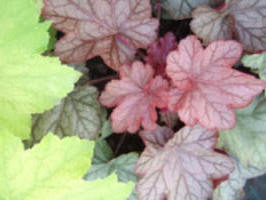 The varieties of Heuchera available these days is remarkable. The varieties of Heuchera available these days is remarkable.
Thanks to the magic of genetic engineering, these excellent shade plants, grown best in masses as ground-cover (more for their foliage than for their delicate and modest Spring flowers) now come in every imaginable leaf color. This site has a number of new varieties. Their "Ginger Ale" is cool.
Tuesday, April 8. 2008
Just grow them, dry them out, punch a 1" hole in them, and hang 'em in a tree. Instant House Wren house. A house is not a home unless you have these members of the chattering class around. (Ours haven't arrived yet this Spring. Global cooling is to blame.)
Sunday, April 6. 2008
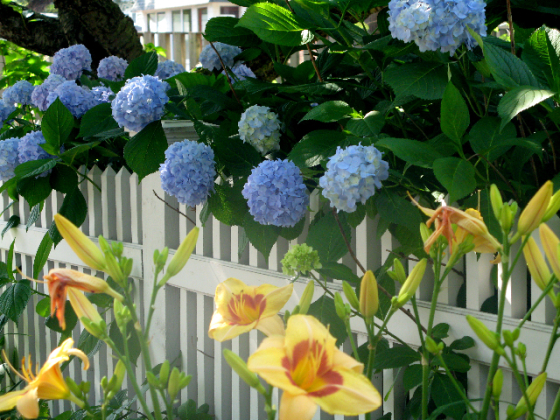 I take a good hammer and pound a 1" dowel into the ground about 12-18" deep, 2-3 holes per shrub (including roses), and fill the dowel hole with a cheap all-purpose fertilizer. I make the holes within the drip-line of the plant. It seems to work well. Fertilizer thrown on the surface just washes away and never gets to the roots. I take a good hammer and pound a 1" dowel into the ground about 12-18" deep, 2-3 holes per shrub (including roses), and fill the dowel hole with a cheap all-purpose fertilizer. I make the holes within the drip-line of the plant. It seems to work well. Fertilizer thrown on the surface just washes away and never gets to the roots.
I do it now, before the leaves emerge in Yankeeland. Roots wake up and start getting active and growing at least 4 weeks before you see any greening - and the roots are the root of the matter. I repeat in June, if I remember and if I feel like it. Definitely twice for the roses, though. They are hogs. If I don't want a plant to grow more vigorously, I don't fertilize it. Incentives, you know. Speaking of outdoor chores, I am working on an update of my Maggie's Farm Exclusive Lawn Care post. I did lime my lawns today, too, despite the icebox weather. The "poor man's fertilizer" adjusts the soil pH around here. It's good that it comes in pelletized form now.
Saturday, April 5. 2008
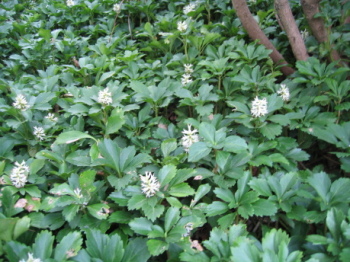 It's a good time of year to re-link our past piece on Removing Pachysandra, that durable shade ground cover which is ubiquitous in these parts and which can be pleasant in the right place, but vulgar, I think, in others. It's a good time of year to re-link our past piece on Removing Pachysandra, that durable shade ground cover which is ubiquitous in these parts and which can be pleasant in the right place, but vulgar, I think, in others.
Getting it established takes some doing, but once it's happy it sure is tough to get rid of. I have a patch to remove, maybe this weekend but my wheelbarrow has a flat so I need to fix that first.
Sunday, March 30. 2008
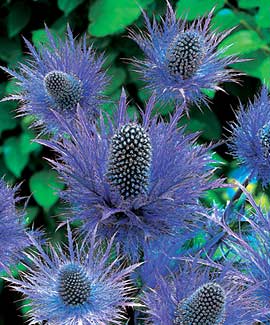 Like all thistles, Sea Holly likes sun and poor or sandy soil. Like all thistles, Sea Holly likes sun and poor or sandy soil.
Like campanula, it's a blue late-summer bloomer for a perennial border. I found this one here. I like it.
Tuesday, March 18. 2008
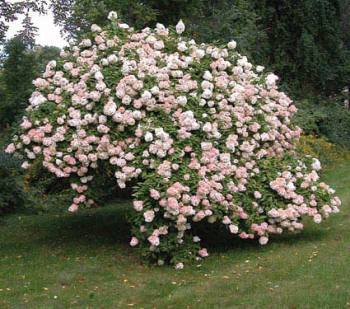 One of my many planned gardening projects this spring is to put in a row of three tree hydrangeas behind a low fence on which my climbing roses grow (they are New Dawn. Note to rose fans: those New Dawn roses need monthly fertilizer during the summer. In fact, all roses want regular feeding or they will not do well). One of my many planned gardening projects this spring is to put in a row of three tree hydrangeas behind a low fence on which my climbing roses grow (they are New Dawn. Note to rose fans: those New Dawn roses need monthly fertilizer during the summer. In fact, all roses want regular feeding or they will not do well).
I like the old-fashioned look of the tree form, and they can be pruned to keep them small for a garden. The one in the photo is too droopy for my taste, I think, but it makes for a living bouquet.
A reader sent us two good arborist sites. I would never go up a tree with a chain saw, but I realize that I might not be all that safe with one even with my feet on the ground. ArboristSite ArborMaster
Saturday, March 8. 2008
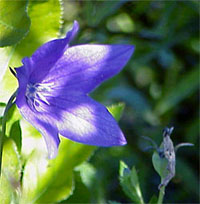 I am told by those who know such things that Platycodon grandiflorus, a member of the Campanula family, belongs in every perennial flower border. I am told by those who know such things that Platycodon grandiflorus, a member of the Campanula family, belongs in every perennial flower border.
It is a tough plant, has interesting buds, good delicate blue flowers, and it blooms in late summer. What else can you ask for from a plant? You can read all about this plant here.
Friday, March 7. 2008
I have been hearing much praise for this year's Philadelphia Flower Show. It is known as the best and the biggest plant and flower show in the country. Should have sent somebody with a camera. Some exhibitors have constructed entire small scale landscapes and gardens - with trees - in the Convention Center. Here's a photo from the show's photo gallery: 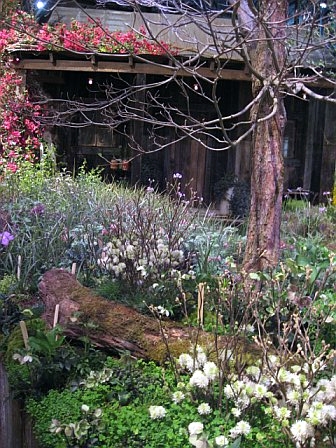
Sunday, March 2. 2008
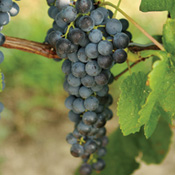 An annual re-post An annual re-post
Miller Nurseries. Our source for hardy fruit trees, grapes, and more. Musser Forests. Our favorite source for seedlings for your farm, game preserve, conservation land, or country place, including Christmas tree plantings. Lots of native plants. Seedland. Great source for large-volume lawn, pasture, game preserve, farm, etc. seeds. I buy meadow clovers from them. For garden seeds, including heirloom vegetables (h/t, readers): 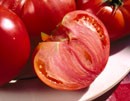 Renee's Renee's
Johnny's The Cook's Garden Gary Ibsen's Tomato Fest (These sound wonderful, but tomatoes from seeds is too much hassle for me)
Wednesday, February 20. 2008
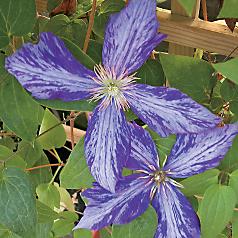 The Tie Dye Clematis, at Wayside. The Tie Dye Clematis, at Wayside.
I'm not sure that it's lovely, but it's interesting.
Tuesday, February 5. 2008
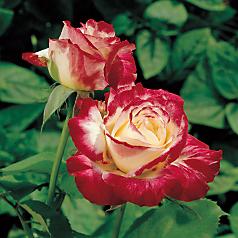 McCain too "mavericky" for you? Mitt too unelectable for you? Hillary and Bill too morally-challenged? Barry O. too lightweight and commy? McCain too "mavericky" for you? Mitt too unelectable for you? Hillary and Bill too morally-challenged? Barry O. too lightweight and commy?
It was ever thus. If you want government to reflect your own views, then run for office yourself. Otherwise, cheer up, quit grumbling, and spend some time with the Spring Wayside catalog. Photo: Rose Double Delight, from the catalog. PS: I do not know who to vote for today. McCain might be able to win an election, but I agree far more with Mitt's current positions. Since appointments to the Supremes is my bottom line, and requires winning, I may hold ye olde schnoz and go with John. Sorry, Mitt - you are one fine fellow and deserve better, but I do not see you winning a national election this year. PPS: We need a Gardening category on the blog.
Editor's note: Indeed we do. I created one, but it will take a while to backtrack. BTW, I am going with Mitt. Tough decision: practicality vs. policy. You are correct, B. - it was ever thus. In this life, we never get exactly what we want, except for lovely roses.
Monday, October 1. 2007
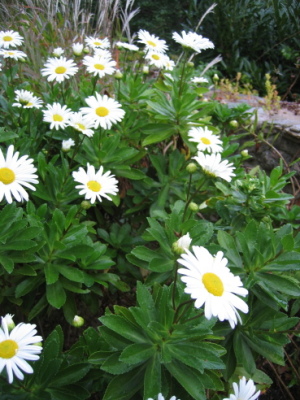 Daisys are the friendliest of garden flowers. Daisys are the friendliest of garden flowers.
Our Montauk daisies (aka nipponicum) have come into bloom this week, which seems very late, but their blooms are welcome. They have woody stems, succulent leaves which bugs leave alone, and perfect flowers. I bought these at Home Depot on a whim, a few years ago. As a beachy plant, this type needs full sun, and seems to enjoy poor soil.
Sunday, September 16. 2007
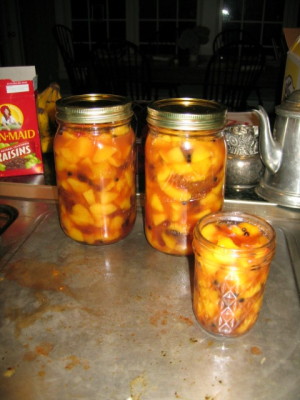 Peaches ripen in early to mid-September in Yankeeland. Peaches ripen in early to mid-September in Yankeeland.
Here's our first batch of peach chutney from our good tree: vinegar, sugar, raisins, hot pepper, whole black peppercorns, spices, lemon juice, raisins, etc. Do not overcook or you will lose that fresh peachy flavor. After we finish the jars of chutney, we'll do some peach pies to spread around the neighborhood. Maybe a couple of peach cobblers too. We have good neighbors,and home-grown and home-made still means a lot in Yankeeland. Important rule: When peeling and slicing, eat every tenth piece. No more, no less. You do it for health. Ripe peaches one hour off the tree have tons of zip to them.
Wednesday, September 5. 2007
We have acres of Wild Thyme in the fields on the Farm, and some parts of the front lawn have more thyme than grass, making mowing a pleasant olfactory experience. We have too much really, because it prospers in areas where the soil is poor, dry, and gravelly, and where there is full sun. When you walk across it on a hot day it fills the air with fragrance and annoys the bees on its purple flowers. No need at all to grow thyme in the garden. You can drive over it occasionally and it doesn't seem to mind. Here's one of our smaller patches, carpeting the entrance to an old rickety shed: 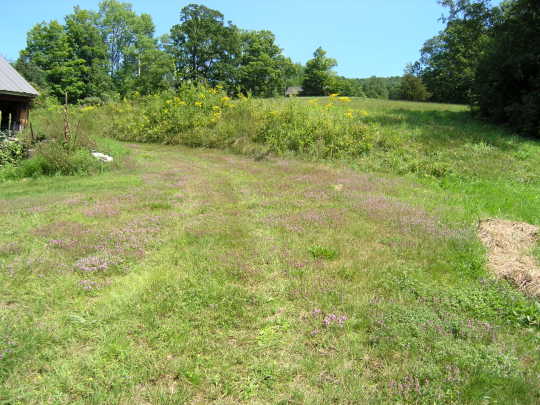
Wednesday, August 29. 2007
Our wild Black Cherries are beginning to ripen, and the trees are filled with robins with purple cherry-stained beaks. I counted 17 happy Robins in one tree this morning. Many of them still have their immature plumage. Black Cherry is a common "pioneer tree" in New England. Some people call them "Chokecherry," but Chokecherry is a different species. Ours tend to be tall, gawky, with a brittle rust-red wood which is great for fires, smoking meat, and for furniture. Here's a low branch of one of mine. The robins have already eaten most of the ripe ones. Not edible for humans: you will choke on them. 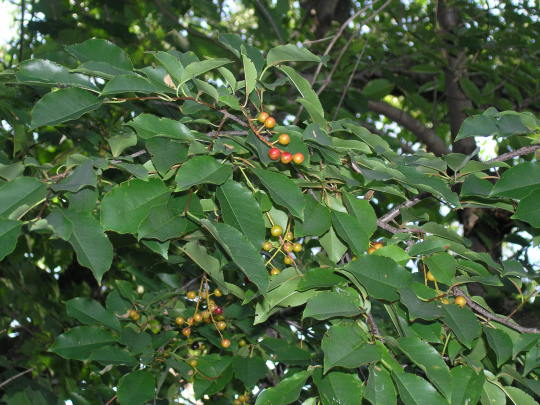
Tuesday, August 21. 2007
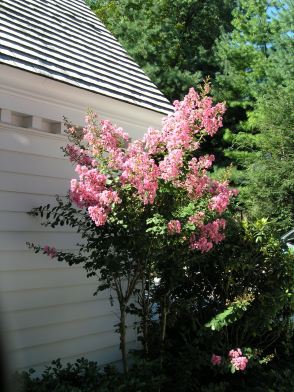 Ours are in bloom now, and will continue through September. These small trees will survive up through Zone 6, but in Zone 6 they prefer some shelter from the winter winds, and they are slow to emerge from dormancy (they look dead). Ours are in bloom now, and will continue through September. These small trees will survive up through Zone 6, but in Zone 6 they prefer some shelter from the winter winds, and they are slow to emerge from dormancy (they look dead).
They are common in the South, but up here people are stunned by such a brilliantly summer-blooming tree and don't know what it is. They like to be pruned properly, and heavily mulched, and need full sun to produce those blooms. A little fertilizer, too. This is a young plant, with three main stems. I much prefer them with multiple stems rather than with a single trunk. The exfoliating bark is interesting too. 51 varieties here, with photos. Most of our cultivars are of Asian descent, but there are native species. More photos, and how to grow them, here. Growing plants on or above their zonal limits is always an interesting challenge for us gardeners. A fully-rational person would not bother.
Wednesday, August 15. 2007
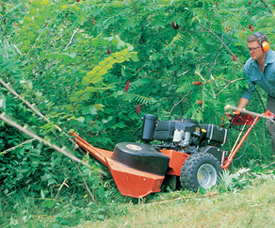 We like all of the DR products (a great Vermont company) but the one we use the most on the farm is our sturdy and indestructible 17 hp Field and Brush Mower. We like all of the DR products (a great Vermont company) but the one we use the most on the farm is our sturdy and indestructible 17 hp Field and Brush Mower.
The machine really does take down 2" saplings and chews them up, and it can run faster than a weary, sweaty, dirty man can walk. The only downside is that using the thing is hard work: you have to muscle it around to turn and maneuver it, and it is heavy. Using it for a few hours ends up being a good work out, unless you are just mowing tall grass on a flat surface. I hate saying it, but it isn't a machine for most females. We tend to use it in places that the tractors can't get to with the brushwacker, and on slopes that are too steep for the tractors.
Wednesday, August 8. 2007
A garden at Villa le Balze, Fiesole, a year and a half ago. The morning mist obscures the view of Florence spread out across the Arno valley below. 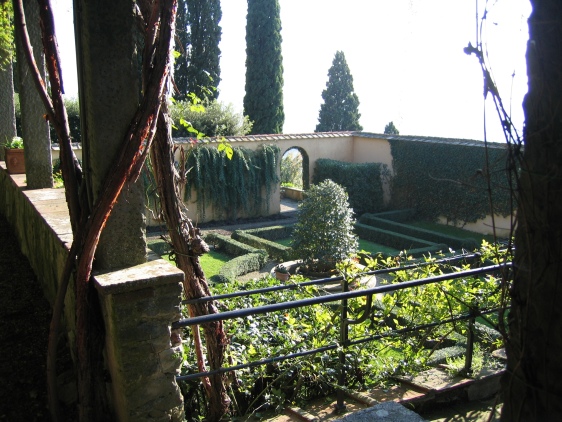
Friday, July 13. 2007
A re-post from last year: The big problem around here 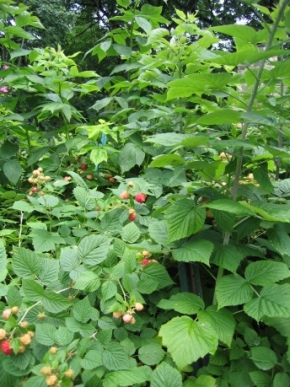
with raspberries, as with cherries and strawberries, is that the birds get them just before they are fully ripe. Or worse, they just peck the red parts off the ripening berry, and leave the rest. It really isn't hardly worth the effort, but one perseveres. Life cannot be entirely economics-driven. Especially Catbirds, but Robins too. Nature sure can be annoying sometimes. We grow three varieties. The birds seem to prefer the big fat French dessert variety. They might be stupid, but they aren't stupid. I have heard that it's a good idea to plant some mulberry trees around, to keep the birds busy. I had a couple, but I had to cut them down because they were shading the garden. Ya sometimes can't win. Even the dog doesn't deter them. I'll try the plastic owl, but they'll get used to it in a day or two, and perch on its head. The only thing finer than a handful of sun-hot raspberries is a sun-heated Beefsteak tomato, but we won't have them for another month. That's one thing the birds will leave alone, but in a dry August, the squirrels and chipmunks will bite hunks out of them for liquids. The simple solution is to grow lots of tomatoes, but the simplest solution is to give up. But that is no fun at all. Man vs. Nature.
Thursday, July 12. 2007
This remarkable site lists 450 gardens (alphabetically and by region) which are open for visiting, with photos of each along with history and design information. Gardens Guide. Below is a garden at Bradenham Hall in Norfolk. 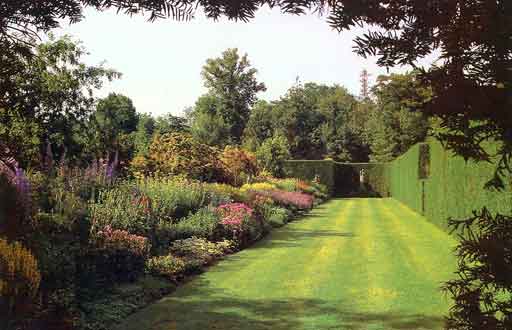
Saturday, June 30. 2007
Here's part of the front shade garden we've been working on completing all Spring. The general idea here is low, mostly horizontal, serene and subtle, which is why this piece of the garden has no Astilbe patch. It has a some morning sun, otherwise Maple shade, except on one end. We re-did this garden about three years ago with deep soil enrichment, so most of the plantings are youthful or new. In a couple of years it should be just right - but every garden is a work in progress. Front to back: Bleeding Heart, Pee Wee hydrangea (which is a dwarf Oak Leaf), assorted rare interesting Hostas, a deciduous Azalea, a couple of low-growing azaleas with hostas in front of them, hybrid rhodies in the corner with a few special low hydrangeas in front of them, a patch of Coral Bells in front a row of Bridal Wreath hydrangeas, and where the photo is washed out, a large patch of Ladie's Mantle. Cinnamon Ferns scattered in the back along the garden. I need my good camera back from Olympus repair. 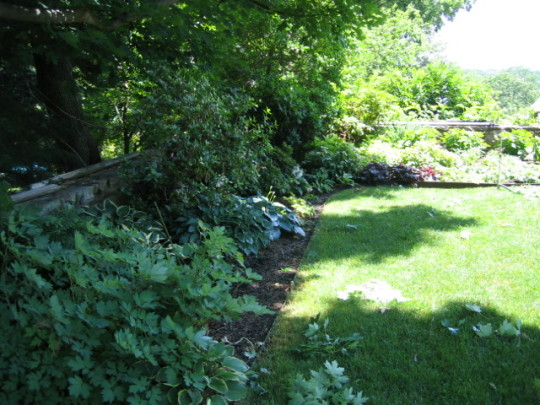
From another angle, here's the newest section. I haven't fully set in the metal edging, and probably never should have bothered with it. The area with the grasses gets the most sun. An orange trumpet vine is trying to climb over the wall and into the garden. I believe a decorator would term that a color clash: 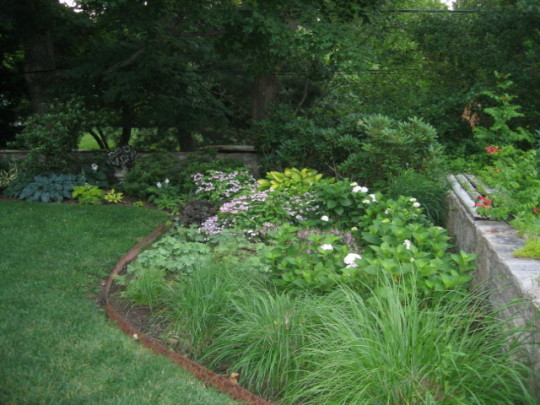
Friday, May 11. 2007
 There is a new magazine out there, Garden and Gun. It sounds like an ideal sort of Maggie's Farm magazine (h/t, Dr. Helen). There is a new magazine out there, Garden and Gun. It sounds like an ideal sort of Maggie's Farm magazine (h/t, Dr. Helen).
With a photo of Pat Conroy on the cover, how bad could it be? I'll give it a try, if only to find out whether it's more interesting than our Maggie's Farm blog. I am certain that it is better-written. Re gun mags, I used to subscribe to Shooting Sportsman, but it has become too snooty for my taste. Informative, though, if you own $60,000 shotguns instead of Mossbergs and Brownings like regular folks.
Monday, April 9. 2007
A bloom of some sort at the New York Botanical Garden orchid show last week: 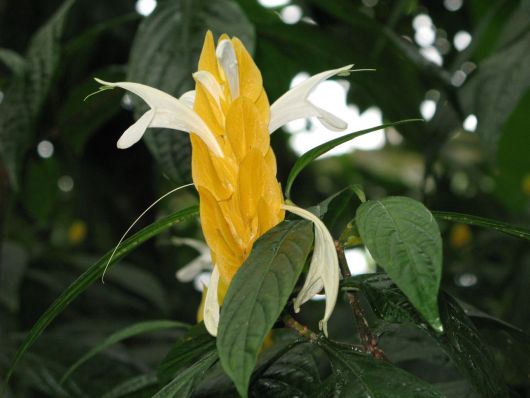
Monday, February 26. 2007
West 28th street in Manhattan has been the flower district for 100 years. I have always enjoyed the way NYC retailers and wholesalers have clumped together for the convenience of their customers and for the convenience of the trucks that deliver to them. The Diamond District, the Fulton Fish Market, the Hunts Point vegetable market, and so on. Heck, there is even a Financial District. Who knew? Such districts have not been created by fiat or by planners, but have grown organically with the relentless logic of market capitalism. 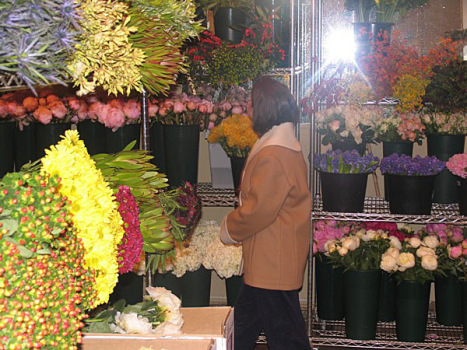
You can find any flower or plant material you want in the Flower District, in almost any reasonable volume. 300 Bell Song tulips? No problem. As the second largest flower market in the world (after Amsterdam), the market serves retailers from MA, NJ, CT, NYS - and further. The vans arrive to load up on their day's purchases at 5 AM. 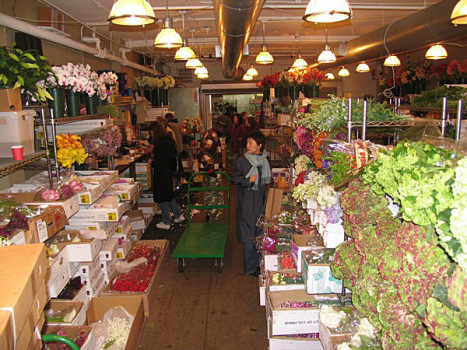
At 6 AM, you will also see a smattering of garden club ladies hunting out stuff for their next creation, which is what brought me and Mrs. Barrister and her pal down to the district from central CT in snow and sleet at o-dark-thirty this morning. I was chauffeur, but I do get a kick out of looking at all of the strange stuff. Some look like science fiction creations, especially some of the strange Protea which, it seems, have been all the rage in recent years. There is one Proteus that looks like eyeballs on a stem. The Greek sea-god was a shape-changer. Her friend wanted these and these, and found them. And some other stuff like the winter Buckeye branches Mrs. B was looking for, plus a ton of pussy willows just for home. As the city changes, the flower district is slowly fading, from over 60 establishments 20 years ago to around 40 right now. But it remains a bustling, thriving place in the early morning. Now I will get out the old plow and do the driveway and the front of the barn so we can let the horses out. Snow day! I'll "work from home" this afternoon by the fire with a few warming glasses of something nice.
|


 The varieties of Heuchera available these days is remarkable.
The varieties of Heuchera available these days is remarkable.  I take a good hammer and pound a 1" dowel into the ground about 12-18" deep, 2-3 holes per shrub (including roses), and fill the dowel hole with a cheap all-purpose fertilizer. I make the holes within the drip-line of the plant. It seems to work well. Fertilizer thrown on the surface just washes away and never gets to the roots.
I take a good hammer and pound a 1" dowel into the ground about 12-18" deep, 2-3 holes per shrub (including roses), and fill the dowel hole with a cheap all-purpose fertilizer. I make the holes within the drip-line of the plant. It seems to work well. Fertilizer thrown on the surface just washes away and never gets to the roots. It's a good time of year to re-link our past piece on
It's a good time of year to re-link our past piece on  Like all thistles, Sea Holly likes sun and poor or sandy soil.
Like all thistles, Sea Holly likes sun and poor or sandy soil. One of my many planned gardening projects this spring is to put in a row of three
One of my many planned gardening projects this spring is to put in a row of three  I am told by those who know such things that Platycodon grandiflorus, a member of the Campanula family, belongs in every perennial flower border.
I am told by those who know such things that Platycodon grandiflorus, a member of the Campanula family, belongs in every perennial flower border.
 An annual re-post
An annual re-post
 The Tie Dye Clematis, at
The Tie Dye Clematis, at  McCain too "mavericky" for you? Mitt too unelectable for you? Hillary and Bill too morally-challenged? Barry O. too lightweight and commy?
McCain too "mavericky" for you? Mitt too unelectable for you? Hillary and Bill too morally-challenged? Barry O. too lightweight and commy?
 Peaches ripen in early to mid-September in Yankeeland.
Peaches ripen in early to mid-September in Yankeeland. 

 Ours are in bloom now, and will continue through September. These small trees will survive up through
Ours are in bloom now, and will continue through September. These small trees will survive up through  We like all of the
We like all of the 




 There is a new magazine out there,
There is a new magazine out there, 

